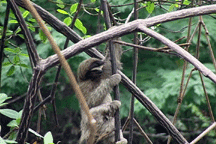|
|
 |

There are two types of sloth: two-toed, the choloepus and three-toed, the bradypus.Two-toed sloths are omnivores, eating leaves, fruits, slow-moving animals and bird eggs. Three-toed sloths are foliavores, subsisting on a variety of leaves.
Sloths live in the rainforest canopies of the Americas, sleeping up to eighteen hours a day. Adept in the trees, they are awkward on the ground, but oddly enough they are strong and graceful swimmers.
Their main defenses are camouflage, stealth and stillness. Should they be attacked they often survive due to their tough hides, tenacious grips and extraordinary ability to heal from grievous wounds. Sloths have been known to survive a ninety-foot fall to the forest floor, and to withstand respiratory arrest for forty minutes.
But the sloths’ world has begun to crumble in recent decades as man encroaches ever further into New World jungles. Rain forests are felled, roads sever their ranges, power lines burn and electrocute them, and dogs attack them. Sometimes children, knowning no better, abuse them. Of the six species of sloths, the Hoffmann’s choloepus is threatened and the bradypus torquatus nears extinction. Another recently discovered species, the bradypus pygmaeus, is very likely endangered but has not yet been listed.
|

The recently-discovered bradypus pygmaeus

Strong and graceful swimmers
|
|
|